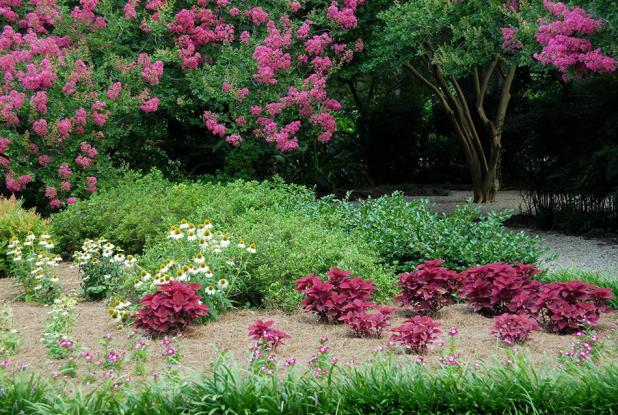
Visiting public gardens such as the LSU AgCenter Botanic Gardens at Burden in Baton Rouge can be therapeutic.
—LSU AgCenter/Rick Bogren
Get It Growing: Plants, the essentials of life
As humans, we need water, food and sleep. OK — more than that. We also need a good immune system, among other things. But thanks to plants and the sun, we as humans can eat, breathe and live. Ultimately, our survival depends on them.
Yes, that’s right. If you haven’t thought about it lately, plants not only sequester gases such as CO2 that affect the atmosphere and acidify the ocean, but they also make food in the form of sugars or carbohydrates and breathable oxygen (O2) that is essential to human life. In the process of food production, plants release oxygen. No animal can do that.
Plants not only make their own food, they also make food for us. The basic food for all organisms is produced by plants. In fact, humans can survive on a purely vegetarian diet.
So how do plants make food and energy for us? They harness energy from the sun. Plants use their roots to take up water and minerals from the ground while their leaves absorb carbon dioxide from the air, a byproduct of human respiration and other processes such as combustion that keeps our vehicles moving. Carbon dioxide can become dangerous when levels are elevated, causing respiratory issues for humans as well as affecting our atmosphere.
In these days of climate change, plants have been shown to help combat global warming by soaking up greenhouse gas emissions. Plants help cool the atmosphere indirectly as part of their natural cooling process; when plants transpire and release water vapor, they help cool the atmosphere.
Plants continue to be studied in an effort to understand their role in reducing carbon dioxide emissions in addition to the relationship of deforestation, reforestation, agricultural practices and the impacts of the urbanization of large cities on climate change and global warming.
Plants do not stop helping. When plants die, they decompose with the help of microorganisms that break down plant debris, thereby becoming organic matter. That includes the three main fertilizer nutrients nitrogen, phosphorus and potassium.
When these decomposed plants as compost are incorporated into the soil, they not only provide nutrients to the plants, but they also help the soil retain moisture while improving drainage and aerating plant roots.
We use plants for so many things. They provide us with food and breathable oxygen. They also produce fiber, wood for making furniture, paper products, shelter, medicine, fuel, perfumes, chewing gum and more.
The wood for building housing and shelter can also be used as fuel to heat our homes and cook our food. Plants also produce fibers to make our clothes in addition to the fiber we get from our diets.
Plants also have been used since the dawn of ages for medicinal purposes. Of the 122 plant-derived drugs, 80% were discovered and passed down through the ages in every place on Earth and by every ethnicity. Plants continue to be studied for their medicinal purposes today. They are an essential source of compounds used for drug research.
Plants also make up a large part of the ecosystem that supports wildlife. Forests, lawns, marshes, bayous and other habitats support biotic communities. The relationship and interaction between plants and animals include food and protection. Not only do these ecosystems support birds, amphibians, reptiles and mammals, but they also support insects. If you don’t think insects are a big thing, you’re mistaken. According to the Smithsonian Institution, insects have the largest biomass of terrestrial animals, with an estimated 10 quintillion individual insects alive in a given day.
Insects and plants have some of the most complex relationships, evolutionarily speaking. Pollinators are responsible for one out of every three bites of food we eat. It’s fascinating, really.
In addition to all of these tangible things, we can also add the importance of the beauty and aesthetics plants offer us, as well. Why do we plant beautiful roses and gorgeous tropical flowers? Is it to attract butterflies and hummingbirds? Oftentimes we do it just for the pure beauty or the fragrance. Flowers are among the No. 1 gifts in every culture.
Humans have been using flowers to communicate for years. In fact, according to FTD, a language of flowers called floriography was developed as a form of communication during the Victorian Age when it was inappropriate, impolite or improper etiquette for humans to express their emotions with one another. Boy, have we come a long way since then. Or have we?
Being in nature among the plants has been studied by health care researchers and practitioners to understand how they help us heal physically and mentally. Ecotherapy, forest therapy and horticulture therapy are real things. Look them up. By spending time in nature or out in your garden, you can develop relaxing routines that offer mental restoration. We can get many physical and therapeutic benefits from plants. This can improve our emotional processing while enhancing our ability to respond and rebound after difficulties, such as stress or illness.
Plants add beauty to our surroundings. They make work and play more enjoyable in addition to adding value to our homes. And they do this all while keeping us alive. As a horticulturist, sometimes I have to sit back and look at the big picture.
At the end of the day, plants and gardening are good for you. We cannot live on this planet without plants. In my opinion, they do more for us than we could ever do for them. My challenge to you is just plant something. Let the beauty restore your mind and soul. And enjoy the oxygen while you’re at it.
